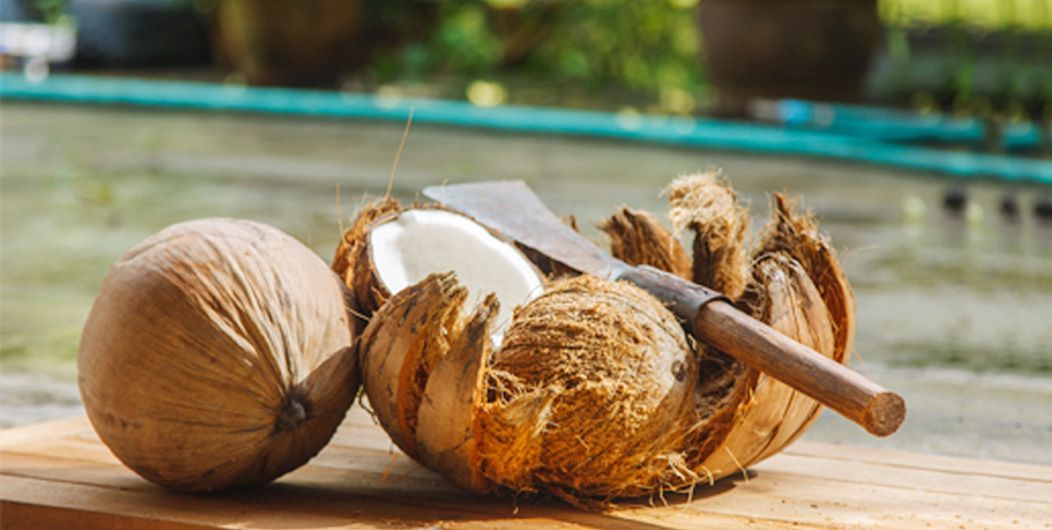
Sri Lanka is the fourth largest coconut products exporter in the world. The country produces value-added coconut-based products to the global market.
Since coconut is an essential part of Sri Lanka’s daily staple nearly ⅔ of the harvest is consumed locally and the rest is exported as value-added ingredients, food and beverages, and products for home and industries. According to the existing demand for coconuts in Sri Lanka, the coconut industry here requires around 4.0 billion nuts but the level of production is only between 2.8 to 3.0 billion.
According to the Coconut Research Institute of Sri Lanka, the sector provides livelihoods to around 700,000 and indirect employment to another 135,000.
By the year 2020, the country had nearly 444,000 hectares of coconut estates out of which 72,000 were managed by large companies and the rest by small and medium holders.
The major portion of coconut holdings (plantations) in Sri Lanka (nearly 75%) belongs to the smallholders while the rest of it belongs to the estate sector where both private and government companies hold ownership. Even though the contribution of the smallholding sector to the total annual coconut production is 70%, this sector is not yet organised well and is thus managed way below the optimal levels.
The annual coconut production in the country today ranges between 2,800 to 3,000 million nuts. To satisfy the demand for both domestic consumption and the processing industry, Sri Lanka must achieve the annual production target of 4,000 million nuts.
To step up the country’s coconut crop, the following strategies are recommended by the Coconut Research Institute of Sri Lanka in their 2016-2020 Strategic Plan.
Companies in the coconut processing industry are mainly engaged in the production of the following.
The desiccated coconut industry is one of the most important food processing industries present on the island. Even during the early 2000s, there were more than 66 desiccated coconut production facilities located within the coconut triangle of Sri Lanka.
The processing capacity of an average factory varies from 30,000 - 40,000 nuts per day with an industry output of around 60,000 tons per annum. At present, Sri Lanka serves only 8% of the demand for desiccated coconut in the EU while the country serves 5% of the overall global demand for fresh and dried coconuts in the world.
A potential rise in the annual coconut production will favour the coconut processing industry in particular because the shortage of nuts is a major issue faced by this industry, which is exacerbated by prolonged droughts. When nuts are in short supply, the price tends to skyrocket which escalates the cost of production. The companies in this sector can step up their production and export volume if the supply of nuts is steady and the price remains reasonable.
Other coconut-based industries such as Coconut-shell based products and coconut fibre-based products are not as much affected by the low coconut yield as the coconut processing industry because the raw materials for their products can be sourced from the coconut used for domestic consumption. Even for those industries, a potential rise in the coconut yield spells an opportunity to bring down the cost of raw material and thereby the cost of production. It also allows them to ramp up their production and step up their turnover.
Even with an annual coconut production of 2,800 to 3,000 million nuts, there’s a good supply of coconut husks even outside of the coconut triangle. But there are logistical and warehousing challenges to tackle in collecting coconut husks, which hampers the growth of coco-fibre and coco-peat based industries. The use of coconut husks as fuel for domestic cooking does serve to limit the supply of coconut husks available for manufacturing both a commodity and a range of value-added products.
Just like coconut husk, Sri Lanka too has a good supply of coconut shell, which is used for the manufacture of coconut shell charcoal and activated carbon, and also to a much lesser extent, for handicraft. The global activated carbon market size was USD 2,856.7 million in 2019 & is projected to reach USD 4,064.7 million by 2027 at a CAGR (Compound Annual Growth Rate) of 4.8% in the forecast period. Increasing demand for water treatment and sewage treatment applications is expected to be a key growth driver. The projected surge in demand for activated carbon does translate into a great growth opportunity for Sri Lankan coconut shell charcoal and activated carbon manufacturers and suppliers.
Sri Lanka is the fourth largest exporter of fresh and dried coconut products in the world with popular exports including desiccated coconut, brown fibre, virgin coconut oil, and coconut water which are available through a number of exporters.
Coconut & Coconut based Products
Info
Directory
eMARKETPLACE
Coconut Peat Products
Directory
eMARKETPLACE
Coconut Ekel products
Directory
eMARKETPLACE
Coconut Water Products
Directory
eMARKETPLACE
Coconut Kernel Products
Directory
eMARKETPLACE
Coconut Fiber Products
Directory
eMARKETPLACE
Coconut Shell Products
Directory
eMARKETPLACE